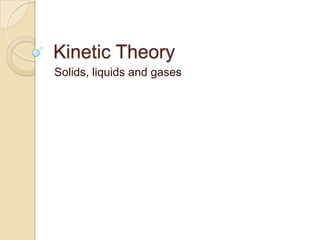
Kinetic theory
- 1. Kinetic Theory Solids, liquids and gases
- 2. States of matter Remember, all substances are made up of tiny particles that are moving. The arrangement of these particles and the way that they are moving determine the properties of the material. The states of matter are: ◦ Solid ◦ Liquid ◦ Gas
- 3. Solids Fixed shape. Fixed volume. High density. Will not flow. Particles in a solid vibrate about a fixed position. The more energy, (heat) in the solid, the faster these particles vibrate.
- 4. Liquids No fixed shape. Fixed volume. Less dense than solids. Will flow. Particles in a liquid can move more freely around each other. As the liquids is heated, the movement becomes more energetic.
- 5. Gases No fixed shape. No fixed volume. Very low density, (allows them to be compressed). Will flow. Particles of gas are moving around randomly all the time. Collisions between the particles and their container causes pressure.
- 6. Changes of state Melting Evaporation Sublimation Solid Liquid Gas Freezing Condensation
- 7. Changes of state As we heat solids the particles start to vibrate more – they gain kinetic energy. We notice the increase in kinetic energy of the particles as an increase in temperature. If the particles are moving rapidly enough, then the solid will melt.
- 8. Changes of state As we heat liquids the movement of the particles becomes even more energetic. If the particles move fast enough then they can break the attractive forces between the particles and move independently. The liquid evaporates to form a gas.
- 9. Brownian motion Named after the botanist Robert Brown (1773-1858). Observed pollen grains moving randomly in water. Thought it might be due to a “life force” in the pollen. However, also observed the movement in non-living particles. Similar effect can be seen in gases.
- 10. Brownian motion Brownian motion was not explained until Particle Theory was developed. Particles in liquids and gases are constantly moving and bump into other particles, such as pollen grains. This causes the random movements of the grain that was observed. A good example is the movement of smoke particles in air.
- 11. Brownian motion
- 12. Absolute zero Absolute zero is the temperature at which it is impossible to cool a gas any further. It is approximately -273oC. The Kelvin temperature scale starts from absolute zero: T = + 273 and = T – 273 (T = temperature in Kelvin, = temperature in Celsius) YOU NEED TO KNOW THIS!
- 13. Kinetic Theory What can you remember?
- 14. States of matter substances Remember, all substances are made particles up of tiny particles that are moving. The arrangement of these particles arrangement moving and the way that they are moving determine the properties of the material. The states of matter are: Solid ◦ Solid Liquid ◦ Liquid Gas ◦ Gas
- 15. Solids Fixedshape. shape. Fixedvolume. High density. density. Will not flow. vibrate Particles in a solid vibrate about a position. heat fixed position. The more energy, (heat) faster in the solid, the faster these particles vibrate.
- 16. Liquids No fixed shape. shape. Fixedvolume. volume. solids. Lessdense than solids. dense Will flow. freely Particles in a liquid can move more freely around each other. As the heated, heated, the movement liquids is energetic.more energetic. becomes
- 17. Gases No fixed shape. shape. No fixed volume. volume. Very low density, (allows them to be density, compressed compressed). Will flow. Particles of gas are moving around Collisions randomly all the time. Collisions between the particles and their pressure. container causes pressure.
- 18. Changes of state Melting Evaporation Sublimation Solid Liquid Gas Freezing Condensation
- 19. Changes of state As we heat solids the particles start to heat vibrate more – they gain kinetic kinetic energy. energy We notice the increase in kinetic temperature. energy of the particles as an increase in temperature. particles melt. If the particles are moving rapidly enough, then the solid will melt.
- 20. Changes of state As we heat liquids the movement of heat movement the particles becomes evenenergetic. more energetic. particles attractive If the particles move fast enough then they can break the attractive forces independently. between the particles and move independently. evaporates gas. The liquid evaporates to form a gas.
- 21. Brownian motion Named after the botanist Robert Brown (1773-1858). Observedpollen grains moving pollen randomly randomly in water. a “life Thought it might be due to “life force” force” in the pollen. However, also observed the non-living in non-living particles. movement Similar effect can be seengases. in gases.
- 22. Brownian motion Brownian motion was not explained Particle Theory until Particle Theory was developed. Particles in liquids and gases are constantlymoving and bump into moving particles, other particles, such as pollen grains. random This causes the random movements of the grain that was observed. A good example is the movement of smoke particles in air.
- 23. Brownian motion
- 24. Absolute zero Absolute zero is the temperature at which it is impossible to cool a gas any further. -273oC. It is approximately -273oC. The Kelvin temperature scale starts Kelvin from absolute zero: T = + 273 and = T – 273 (T = temperature in Kelvin, = temperature in Celsius) YOU NEED TO KNOW THIS!